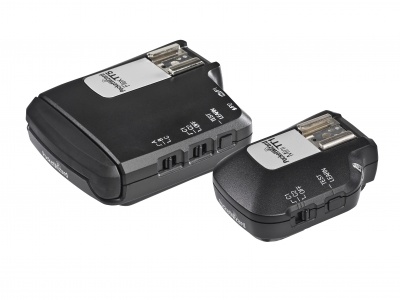MiniTT1 and FlexTT5
The Canon-specific MiniTT1 and FlexTT5 radios work within the Canon E-TTL II system.
The Nikon-specific MiniTT1 and FlexTT5 radios work within the Nikon i-TTL / CLS system.
All references to TTL are exclusively for the electronic or intelligent TTL systems specific to Canon (E-TTL II) and Nikon (i-TTL / CLS), and not film TTL.
The terms Speedlite or Speedlight are used interchangeably throughout this wiki.
This wiki contains the latest information about the operation of your radios. If you would like to download a PDF of this information, click here and follow the instructions.
| Note: The FlexTT6 was created to make the newest generation of Canon cameras (such as the 1DX Mark II and 5D Mark IV) compatible with our ControlTL system. The difference between the FlexTT6 and FlexTT5 is a circuit board hardware change. The functions of the radios are identical. Any information or videos you see, with the exception of compatible cameras, is identical between the FlexTT6 and FlexTT5. To use a FlexTT5 with a FlexTT6, the FlexTT5 will need to be updated to firmware version 6.905 or later to function properly. |
Operation
To quickly begin using your radio, you might be interested in the Quick Guides or other documentation at PocketWizard.com.
For more detailed information, use the links below to hone in on the specific feature you are looking for. The links are the section headings. For example, the words Getting Started below will take you straight to that section.
Getting Started
Information you should know before using your radios. Also referred to as "READ ME FIRST" information.
Key Features
Learn more about the key features of your MiniTT1 and FlexTT5. Additional information on features can also be found at PocketWizard.com
MiniTT1 and FlexTT5 FAQ
Having trouble with your MiniTT1 or FlexTT5? Check out our MiniTT1 and FlexTT5 FAQ page!
Safety Warnings
Information about operating the radios safely can be found here.
Nikon Compatibility
Find out exactly what cameras and flashes work with the Nikon-Specific ControlTL radios, and what specific operational considerations are required for your gear.
Canon Compatibility
Find out exactly what cameras and flashes work with the Canon-specific ControlTL radios, and what specific operational considerations are required for your gear.
Batteries
Battery types, polarity, and life expectancy information.
PocketWizard Utility
Connect your radios to your computer via USB and control many aspects of them via the PocketWizard Utility.
Basic Wireless TTL
Simple TTL operation instructions. Use all of your Speedlites as one zone of light with the camera making the exposure decision.
Advanced Wireless TTL
Advanced i-TTL operation instructions. Control individual zones of light. Control your remote Speedlights manually from the camera position.
Manual Flash
Trigger any remote flash simply.
PowerTracking
Trigger a compatible remote studio flash and control its power level directly from the camera position.
HyperSync
Learn more about increasing your X-Sync speed using HyperSync.
High Speed Sync / Auto FP
Use your Speedlites with your camera's fastest shutter speeds. See Understanding HyperSync and High Speed Sync.
Channels
Channels allow you to work collaboratively with other photographers, or to work with your radios exclusively.
Learn Mode
Learn Mode is not required for normal operation of your radios, but if you are working away from the PocketWizard Utility and in conflict with another photographer on your channel, Learn Mode allows you to change channels in the field.
Remote Camera Triggering
In addition to triggering remote flash, your PocketWizard radios can trigger a remote camera's motor drive port. Relay Mode is covered in this section.
Factory Reset
Sometimes you just need the settings in your radio to be like they were when you first took them out of the box.
Status LED
This section covers the various colors and blink patterns used by the Status LED.
Mounting
Radios perform best when mounted properly.
Long Range Performance
Optimize range using these techniques.
MiniTT1 and FlexTT5 Specifications
Details on radio specifics are found here.
FCC Notice
The FCC wants you to know...
